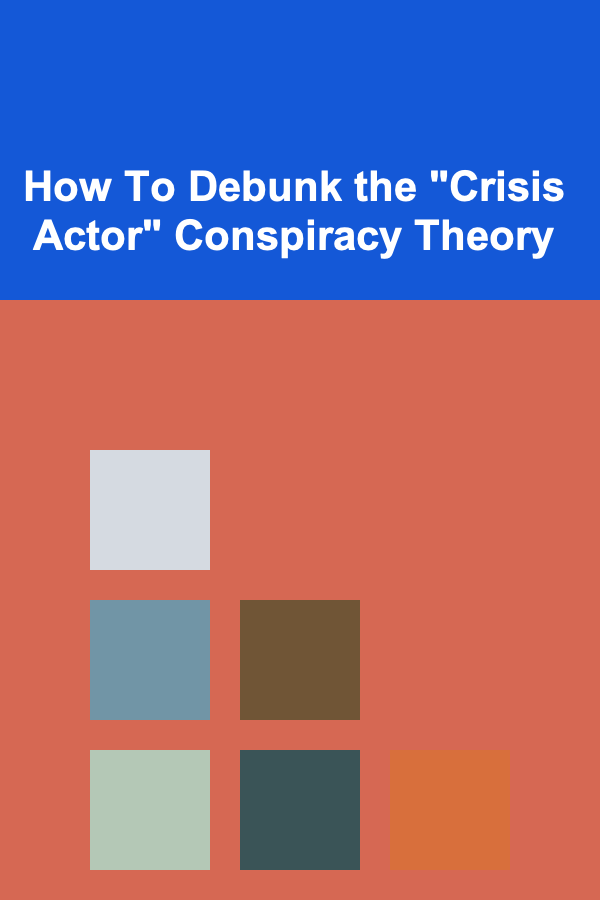
How To Debunk the "Crisis Actor" Conspiracy Theory
ebook include PDF & Audio bundle (Micro Guide)
$12.99$5.99
Limited Time Offer! Order within the next:

In the era of rapid information exchange, especially through social media, the spread of conspiracy theories has become a significant challenge. Among the most disturbing and harmful of these theories is the "crisis actor" conspiracy theory. This theory claims that individuals hired by shadowy groups or governments play the role of victims or perpetrators during tragic events, such as mass shootings, natural disasters, or terrorist attacks. These individuals are alleged to be nothing more than actors hired to fabricate stories and manipulate public perception. The purpose of this article is to provide a comprehensive analysis of this conspiracy theory, examining its origins, the psychological reasons behind its popularity, and the factual evidence that debunks it.
Understanding the Crisis Actor Theory
At its core, the "crisis actor" theory suggests that certain traumatic events---especially those involving violence or large-scale tragedy---are staged by governments, organizations, or other powerful groups. According to proponents of this theory, the people who appear in news reports, interviews, or social media posts following these events are not real victims but actors who have been paid to portray victims or witnesses. This theory gained widespread attention after the 2012 Sandy Hook Elementary School shooting and has resurfaced in the aftermath of numerous other incidents.
The conspiracy often implies that mass shootings, natural disasters, or terror attacks are hoaxes, and the real goal behind the staged events is to push a hidden agenda, such as increasing government control, passing new laws, or promoting political or ideological narratives. The idea is that the media, in collusion with these groups, is either complicit or deliberately misleading the public to maintain a particular agenda.
The Origin and Popularization of the "Crisis Actor" Conspiracy Theory
The "crisis actor" conspiracy theory is not a new phenomenon. It draws from older conspiracy narratives and blends them with modern media technologies and platforms. One of the first significant instances where the "crisis actor" theory gained attention was in the aftermath of the Sandy Hook Elementary School shooting in 2012. After the event, certain online groups began circulating videos and articles claiming that some of the victims were actors, hired by the government to create a fake narrative around the shooting.
This theory gained further traction due to the rise of social media, where anyone can post content without any oversight or fact-checking. Platforms like YouTube, Facebook, and Twitter enabled the viral spread of these theories, often accompanied by misleading or entirely fabricated evidence, such as photos of people allegedly appearing at different crisis events. Over time, the theory expanded to include a wide range of events, from the Boston Marathon bombing to the Parkland shooting, and even natural disasters like hurricanes.
The narrative feeds into a broader mistrust of government, media, and authority, with the conspiracy suggesting that the public is being manipulated for nefarious purposes. The theory has also been linked to other broader conspiracy movements, such as those questioning the legitimacy of major historical events (e.g., 9/11 or the moon landing).
Psychological Drivers of Belief in the "Crisis Actor" Theory
To understand why some people believe in such a theory, it is important to look at the psychological factors that contribute to its appeal. The belief in conspiracy theories, especially one as far-fetched as the "crisis actor" theory, can often be traced to several cognitive biases and emotional responses.
1. Cognitive Dissonance
Cognitive dissonance occurs when individuals experience discomfort due to conflicting information. When people are confronted with a tragic or unsettling event, they may find it difficult to process the reality of the situation. Instead of accepting the event as a harsh reality, which may provoke feelings of fear or helplessness, some may seek out alternative explanations that are less emotionally distressing.
The crisis actor theory offers a way for individuals to distance themselves from the emotional discomfort associated with real tragedies. By suggesting that the event is a hoax, they can maintain a sense of control and understanding, avoiding the vulnerability that comes with acknowledging the genuine harm caused by these events.
2. Confirmation Bias
People are more likely to accept information that confirms their preexisting beliefs and to reject information that contradicts those beliefs. For individuals who already harbor a mistrust of government, the media, or authority figures, the crisis actor theory is a convenient narrative that aligns with their worldview. These individuals may be more inclined to believe in conspiracy theories because they fit neatly into their broader suspicions about societal structures and power dynamics.
3. Pattern Recognition
Human beings are wired to recognize patterns, which is an adaptive trait for survival. However, this instinct can sometimes lead to incorrect conclusions, especially in situations where the evidence is ambiguous or lacking. In the case of the "crisis actor" theory, proponents often point to perceived patterns---such as the reappearance of the same people in different tragedies---as evidence that something nefarious is going on. However, these patterns are often the result of coincidence, media manipulation, or selective attention, rather than deliberate deception.
4. Need for Control and Certainty
Conspiracy theories often thrive in environments of uncertainty and fear. In the aftermath of a traumatic event, individuals may feel a lack of control over the world around them. Believing in a conspiracy theory can provide a sense of certainty and control. By explaining events in terms of hidden, manipulative forces, individuals can feel that they are "in the know" and that they understand the true causes behind the chaos.
Debunking the "Crisis Actor" Theory with Evidence
The "crisis actor" conspiracy theory relies heavily on anecdotal evidence, cherry-picked images, and misinformation to make its case. However, a closer examination of the theory reveals numerous inconsistencies, factual inaccuracies, and logical flaws. Let's break down some of the common claims made by proponents of the theory and offer evidence to debunk them.
1. The Claim of Actors Appearing in Multiple Events
One of the most common arguments put forward by crisis actor conspiracy theorists is that certain individuals appear at multiple crisis events, suggesting that they are actors playing different roles. This claim is often based on side-by-side comparisons of photographs or video clips, with theorists arguing that the same people appear in different places at different times.
In reality, these claims can be explained by the presence of real survivors or witnesses who are, unfortunately, involved in multiple tragic events. People who experience trauma may become outspoken advocates or activists, participating in memorials, interviews, or documentaries. For example, a parent who lost a child in a school shooting may also become involved in campaigns to prevent gun violence. This involvement in different events may result in these individuals being photographed or filmed on multiple occasions, but it does not mean they are "crisis actors."
Moreover, in today's digital age, it is not uncommon for people to be involved in several significant events, especially if they have a platform or personal experience that makes them relevant to multiple causes.
2. The Absence of Concrete Evidence
Despite the many rumors and online posts claiming to have uncovered "proof" of crisis actors, there is no concrete evidence that supports the idea of hired actors being involved in these events. The lack of verifiable evidence makes the theory highly speculative and unreliable. The individuals accused of being crisis actors are often regular citizens, and their personal histories or involvement in different events can typically be traced back to genuine, documented experiences.
Furthermore, the idea that large-scale conspiracies involving numerous actors, media outlets, and governmental organizations could remain hidden for years is highly improbable. The logistics of orchestrating such events would be extraordinarily complex and difficult to keep secret, especially in an era where information can be disseminated so quickly.
3. The Role of the Media
Another common claim from conspiracy theorists is that the media is complicit in the "crisis actor" narrative, deliberately promoting false stories to push a political or ideological agenda. In reality, the role of the media is not to fabricate events but to report on them. The media may make mistakes in their coverage, but there is no credible evidence to suggest that they are involved in any deliberate effort to stage events or manipulate the public.
In fact, the media has played an essential role in uncovering the truth about the individuals behind these theories. Investigations by journalists and fact-checking organizations have debunked the claims of crisis actors, exposing the real identities and backgrounds of those involved.
4. The Logic of Conspiracy Theories
Conspiracy theories thrive on a lack of critical thinking. They often appeal to people's emotions and make sweeping claims without providing solid evidence. The "crisis actor" theory, in particular, requires an extraordinary amount of suspension of disbelief. The notion that such complex events, involving thousands of people and organizations, could be staged without anyone leaking information is highly unlikely.
Moreover, these theories often ignore simpler, more plausible explanations. For example, the fact that many victims or witnesses in traumatic events share similar reactions, such as shock or grief, does not imply that they are actors. Instead, it reflects the universal human response to tragedy.
Conclusion
The "crisis actor" conspiracy theory is a deeply flawed and harmful narrative that seeks to undermine the authenticity of real-life tragedies and the experiences of those involved. By understanding the psychological factors that contribute to its appeal and examining the factual evidence that debunks it, we can begin to dismantle the false claims that fuel such theories. It is essential for individuals to engage in critical thinking, question the sources of information they consume, and rely on credible evidence rather than anecdotal rumors and unverified claims.
Debunking the "crisis actor" theory is not just about dispelling misinformation; it is about protecting the dignity of real victims and ensuring that we do not allow conspiracy theories to undermine the importance of truth, justice, and accountability.
Reading More From Our Other Websites
- [Home Space Saving 101] How to Organize Your Closet System for Maximum Space Efficiency
- [Home Staging 101] How to Stage a Home for Open Houses: Maximizing Impact
- [Organization Tip 101] How to Create an Inviting Shared Outdoor Area
- [Personal Investment 101] How to License Your Deep Learning Models for Ongoing Profits
- [Personal Financial Planning 101] How to Protect Your Finances from Inflation and Economic Downturns
- [Organization Tip 101] How to Organize Your Home Office Supplies Like a Pro
- [Personal Care Tips 101] How to Use Hair Gel to Protect your Hair from Humidity and Frizz
- [Home Security 101] How to Choose the Right Safe for Your Home and Valuables
- [Home Staging 101] How to Stage a Luxury Home to Attract High-End Buyers
- [Home Pet Care 101] The Best Toys for Destructive Chewers

Creating Value: The Role of the Chief Executive Officer in Strategic Growth
Read More
How to Make Money Online as a Data Science Consultant: 10 Actionable Ideas
Read More
How to Make Money Online as a Pinterest Strategist: 10 Actionable Ideas
Read More
How to Offer Real Estate Virtual Tours as a Service
Read More
How to Start Delivering Packages for E-Commerce Platforms: An Actionable Guide
Read More
How to Use Wall Hangings for Added Sound Absorption
Read MoreOther Products

Creating Value: The Role of the Chief Executive Officer in Strategic Growth
Read More
How to Make Money Online as a Data Science Consultant: 10 Actionable Ideas
Read More
How to Make Money Online as a Pinterest Strategist: 10 Actionable Ideas
Read More
How to Offer Real Estate Virtual Tours as a Service
Read More
How to Start Delivering Packages for E-Commerce Platforms: An Actionable Guide
Read More